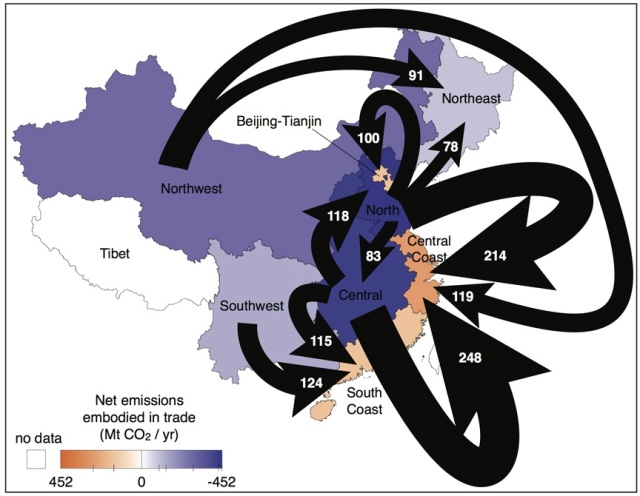Jun 11 2013
Just as wealthy nations like the United States are outsourcing their dangerous carbon dioxide emissions to China, rich coastal provinces in that country are outsourcing emissions to poorer provinces in the interior, according to UC Irvine climate change researcher Steve Davis and colleagues.
 Arrows on the map show millions of tons of carbon dioxide emissions embodied in goods and services traded among Chinese provinces. Poor interior provinces are net exporters of emissions (blue), providing carbon-intensive goods and services to richer coastal provinces (red). (Steve Davis / UC Irvine)
Arrows on the map show millions of tons of carbon dioxide emissions embodied in goods and services traded among Chinese provinces. Poor interior provinces are net exporters of emissions (blue), providing carbon-intensive goods and services to richer coastal provinces (red). (Steve Davis / UC Irvine)
The findings, to be published the week of June 10 in Proceedings of the National Academy of Sciences show that more developed areas such as Beijing and Shanghai import steel, heavy industrial equipment and other materials from provinces such as Inner Mongolia, where highly polluting manufacturing facilities produce the raw goods.
Davis and fellow researchers discovered that up to 80 percent of emissions related to items consumed in the coastal provinces are actually released skyward in the less developed provinces in central and western China.
China’s province-specific pollution abatement targets, adopted in 2009 as part of the Copenhagen Accord to cut the carbon dioxide emissions causing global climate change, are likely to encourage even more of this type of domestic outsourcing, Davis noted. The less developed heartland is not required to cut as much of the dangerous greenhouse gas.
“This is regrettable, because the cheapest and easiest reductions – the low-hanging fruit – are in the interior provinces, where modest technological improvements could make a huge difference in emissions,” said Davis, a UC Irvine Earth system scientist and attorney specializing in climate policy. “Richer areas currently have much tougher targets, so it’s easier for them to just buy goods made elsewhere. A nationwide target that tracks emissions embodied in trade would go a long way toward solving the problem. But that’s not what’s happening.”
The research data was obtained from a variety of sources by Davis and colleagues at the University of Maryland, the University of London, Austria’s International Institute for Applied Systems Analysis, the University of Leeds, the Chinese Academy of Sciences, the University of Cambridge and the University of Chinese Academy of Sciences.
They tracked carbon emissions related to goods both within China and internationally using a global model of 129 regions, including 107 individual countries and 57 industry sectors. China was then broken down into 30 subregions comprising 26 provinces and four cities.
“As the world’s largest emitter of carbon dioxide, China is a prominent and important example, struggling to balance rapid economic growth and environmental sustainability across provinces that are in very different stages of development,” the authors conclude.